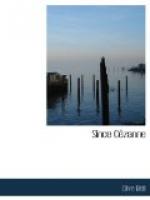Only a fool could suppose that the ancients were less sensitive to art than we are. Since they were capable of producing great art it seems silly to pretend that they were incapable of appreciating it. We need not be dismayed by the stories of Apelles and Polygnotus with their plums and sparrows. These are merely the instruments of criticism: by such crude means did ancient critics excite the public and try to express their own subtle feelings. If anyone seriously believes that the Athenians admired the great figures on the Parthenon for their fidelity to Nature I would invite him to take into consideration the fact that they are not faithful at all. More probably a sensitive Athenian admired them for much the same reasons as we admire them. He felt much what we feel: only, he expressed his admiration and thus provoked the admiration of others, by calling these grand, distorted, or “idealized” figures “lifelike.” Reading the incomparable Vasari, one is not more struck by his sensibility and enthusiasm than by the improbability of his having liked the pictures he did like for the childish reasons he is apt to allege. Could anyone be moved by the verisimilitude of Uccello? I forget whether that is what Vasari commends: what I am sure of is that he was moved by the same beauties that move us.
The fact is, it matters hardly at all what words the critic employs provided they have the power of infecting his audience with his genuine enthusiasm for an authentic work of art. No one can state in words just what he feels about a work of art—especially about a work of visual art. He may exclaim; indeed, if he be a critic he should exclaim, for that is how he arrests the public. He may go on to seek some rough equivalent in words for his excited feelings. But whatever he may say will amount to little more than steam let off. He cannot describe his feelings; he can only make it clear that he has them. That is why analytical criticism of painting and music is always beside the mark: neither, I think, is analytical criticism of literary art much more profitable. With literature that is not pure art the case is different, facts and ideas being, of course, the analyst’s natural prey. But before a work of art the critic can do little more than jump for joy. And that is all he need do if, like Cherubino, he is “good at jumping.” The warmth and truth of Vasari’s sentiment comes straight through all his nonsense. Because he really felt he can still arrest.




